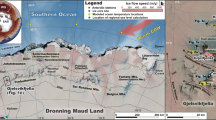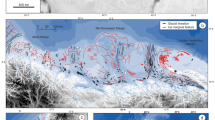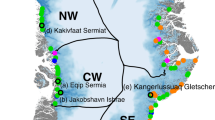Abstract
The demise of the Laurentide ice sheet during the early Holocene epoch is the most recent and best constrained disappearance of a large ice sheet in the Northern Hemisphere, and thus allows an assessment of rates of ice-sheet decay as well as attendant contributions to sea level rise. Here, we use terrestrial and marine records of the deglaciation to identify two periods of rapid melting during the final demise of the Laurentide ice sheet, when melting ice contributed about 1.3 and 0.7 cm of sea level rise per year, respectively. Our simulations with a fully coupled ocean–atmosphere model suggest that increased ablation due to enhanced early Holocene boreal summer insolation was the predominant cause of Laurentide ice-sheet retreat. Although the surface radiative forcing in boreal summer during the early Holocene is twice as large as the greenhouse-gas forcing expected by the year 2100, the associated increase in summer surface air temperatures is very similar. We conclude that our geologic evidence for a rapid retreat of the Laurentide ice sheet may therefore describe a prehistoric precedent for mass balance changes of the Greenland ice sheet over the coming century.
This is a preview of subscription content, access via your institution
Access options
Subscribe to this journal
Receive 12 print issues and online access
$259.00 per year
only $21.58 per issue
Buy this article
- Purchase on Springer Link
- Instant access to full article PDF
Prices may be subject to local taxes which are calculated during checkout



Similar content being viewed by others
References
Solomon, S. D., Manning, M. & Qin, D. (eds) Climate Change 2007: The Physical Basis 4th Assessment Report, IPCC 18 (Cambridge Univ. Press, Cambridge, 2007).
Alley, R. B., Clark, P. U., Huybrechts, P. & Joughin, I. Ice-sheet and sea-level changes. Science 310, 456–460 (2005).
Wild, M., Calanca, P., Scherrer, S. C. & Ohmura, A. Effects of polar ice sheets on global sea level in high-resolution greenhouse scenarios. J. Geophys. Res. 108, doi:10.1029/2002JD002451 (2003).
Ridley, J. K., Huybrechts, P., Gregory, J. M. & Lowe, J. A. Elimination of the Greenland Ice Sheet in a high CO2 climate. J. Clim. 18, 3409–3427 (2005).
Gregory, J. M., Huybrechts, P. & Raper, S. C. B. Threatened loss of the Greenland ice-sheet. Nature 428, 616. (2004).
Berger, L. & Loutre, M. F. Insolation values for the climate of the last 10 million years. Quat. Sci. Rev. 17, 211–219 (1991).
Licciardi, J. M., Clark, P. U., Jenson, J. W. & MacAyeal, D. R. Deglaciation of a soft-bedded Laurentide Ice Sheet. Quat. Sci. Rev. 17, 427–488 (1998).
Mitchell, J. F. B., Grahame, N. S. & Needham, K. J. Climate simulations for 9000 years before present: Seasonal variations and effect of the Laurentide Ice Sheet. J. Geophys. Res. Atmos. 93, 8283–8303 (1988).
Pollard, D., Bergengren, J. C., Stillwell-Soller, L. M., Felzer, B. & Thompson, S. L. Climate simulations for 10,000 and 6,000 years BP. Paleoclimates 2, 183–218 (1998).
Kaufman, D. S. et al. Holocene thermal maximum in the western Arctic (0–180∘ W). Quat. Sci. Rev. 23, 529–560 (2004).
Kaplan, M. R. & Wolfe, A. P. Spatial and temporal variability of Holocene temperature in the north Atlantic. Quat. Res. 65, 223–231 (2006).
Came, R. E., Oppo, D. W. & McManus, J. F. Amplitude and timing of temperature and salinity variability in the subpolar North Atlantic over the past 10 k.y. Geology 35, 315–318 (2007).
Hillaire-Marcel, C., de Vernal, A., Bilodeau, G. & Weaver, A. J. Absence of deep-water formation in the Labrador Sea during the last interglacial period. Nature 410, 1073–1077 (2001).
Carlson, A. E., Clark, P. U., Raisbeck, G. M. & Brook, E. J. Rapid Holocene deglaciation of the Labrador sector of the Laurentide Ice Sheet. J. Clim. 20, 5126–5133 (2007).
Peltier, W. R. Global glacial isostasy and the surface of the ice-age Earth: The ICE-5G (VM2) Model and GRACE. Annu. Rev. Earth Planet. Sci 32, 111–149 (2004).
Fairbanks, R. G. A 17,000 year glacio-eustatic sea level record: Influence of glacial melting rates on the Younger Dryas event and deep ocean circulation. Nature 342, 637–642 (1989).
Bard, E. B. et al. Deglacial sea-level record from Tahiti corals and the timing of global meltwater discharge. Nature 382, 241–244 (1996).
Cronin, T. M. et al. Rapid sea level rise and ice sheet response to 8,200-year climate event. Geophys. Res. Lett. 34, doi:10.1029/2007GL031318 (2007).
Yu, S.-Y., Berglund, B. E., Sandgren, P. & Lambeck, K. Evidence for a rapid sea-level rise 7600 yr ago. Geology 35, 891–894 (2007).
Dyke, A. S. in Quaternary Glaciations-Extent and Chronology Part II Vol. 2b (eds Ehlers, J. & Gibbard, P. L.) 373–424 (Elsevier, Amsterdam, 2004).
Barber, D. C. et al. Forcing of the cold event of 8,200 years ago by catastrophic drainage of Laurentide lakes. Nature 400, 344–348 (1999).
Clark, P. U., Brook, E. J., Raisbeck, G. M., Yiou, F. & Clark, J. Cosmogenic 10Be ages of the Saglek Moraines, Torngat Mountains, Labrador. Geology 31, 617–620 (2003).
Miller, G. H., Wolfe, A. P., Briner, J. P., Sauer, P. E. & Nesje, A. Holocene glaciation and climate evolution of Baffin Island, Arctic Canada. Quat. Sci. Rev. 24, 1703–1721 (2005).
Hillaire-Marcel, C. & Bilodeau, G. Instabilities in the Labrador Sea water mass structure during the last climatic cycle. Can. J. Earth Sci. 37, 795–809 (2000).
Hillaire-Marcel, C., de Vernal, A. & Piper, D. J. W. Lake Agassiz final drainage event in the northwest North Atlantic. Geophys. Res. Lett. 34, doi:10.1029/2007GL030396 (2007).
Keigin, L. D., Sachs, J. P., Rosenthal, Y. & Boyle, E. A. The 8200 year B.P. event in the slope water system, western subpolar north Atlantic. Paleoceanography 20, doi:10.1029/2004PA001074 (2005).
LeGrande, A. N. et al. Consistent simulations of multiple proxy responses to an abrupt climate change event. Proc. Natl Acad. Sci. 103, 837–842 (2006).
Paterson, W. S. B. The Physics of Glaciers (Butterworth-Heinemann, Oxford, 1994).
Schmidt, G. A., LeGrande, A. N. & Hoffmann, G. Water isotope expressions of intrinsic and forced variability in a coupled ocean-atmosphere model. J. Geophys. Res. Atmos. 112, doi:10.1029/2006JD007781 (2007).
Hansen, J. et al. Dangerous human-made interferences with climate: a GISS modelE study. Atmos. Chem. Phys. 7, 2287–2312 (2007).
Acknowledgements
We would like to thank J. Stoner for discussion of Orphan Knoll cores, and L. Keigwin and L. Skinner for sharing data. This research was financially supported by National Science Foundation grants ATM-05-01351 & ATM-05-01241 to D.W.O. and G.A.S., start-up funds from the University of Wisconsin-Madison and a Woods Hole Oceanographic Institution Postdoctoral Scholarship to A.E.C., and the Woods Hole Oceanographic Institution’s Ocean and Climate Change Institute (D.W.O. and R.E.C.).
Author information
Authors and Affiliations
Contributions
A.E.C. compiled terrestrial and marine records of LIS retreat. A.N.L. and G.A.S. developed the AOGCM model. A.N.L. initiated and analysed the 9 kyr BP simulations. A.N.L., G.A.S., A.E.C. and J.M.L. designed model boundary conditions. A.E.C., R.E.C., E.A.O. and D.W.O. compiled oxygen isotope data. A.N.L., A.E.C. and F.S.A. interpreted LIS mass balance. All authors collaborated on the text.
Corresponding author
Supplementary information
Supplementary Information
Supplementary figures S1-S4 and tables S1-S2 (PDF 5338 kb)
Rights and permissions
About this article
Cite this article
Carlson, A., LeGrande, A., Oppo, D. et al. Rapid early Holocene deglaciation of the Laurentide ice sheet. Nature Geosci 1, 620–624 (2008). https://doi.org/10.1038/ngeo285
Received:
Accepted:
Published:
Issue Date:
DOI: https://doi.org/10.1038/ngeo285
This article is cited by
-
Dampened predictable decadal North Atlantic climate fluctuations due to ice melting
Nature Geoscience (2023)
-
Holocene temperature variation recorded by branched glycerol dialkyl glycerol tetraethers in a loess-paleosol sequence from the north-eastern Tibetan Plateau
Frontiers of Earth Science (2023)
-
Freshwater forcing of the Atlantic Meridional Overturning Circulation revisited
Nature Climate Change (2022)
-
First fluvial archive of the 8.2 and 7.6–7.3 ka events in North Africa (Charef River, High Plateaus, NE Morocco)
Scientific Reports (2022)
-
Holocene seasonal temperature evolution and spatial variability over the Northern Hemisphere landmass
Nature Communications (2022)



